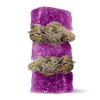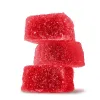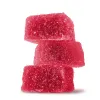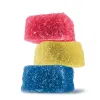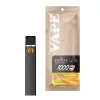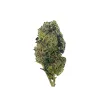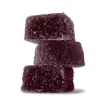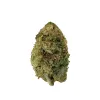Myrcene, a prevalent terpene in numerous plant species, holds a significant place in the world of aromatics and wellness.
In this article, we delve into the frequently asked questions about myrcene, its diverse effects, and its presence in various botanical sources. From its structural characteristics to its potential health benefits, we'll uncover the essential aspects of this intriguing compound.
What is the Myrcene Terpene?
Myrcene is a type of monoterpene, a compound produced by many plants that impart aroma and flavor. As an abundant terpene in botanical essential oils, myrcene contributes significantly to the fragrance profiles of various plants.
It can comprise up to 50% of the essential oil of hops, providing the characteristic smell we associate with beer. Myrcene also occurs in numerous fruits, herbs, and other plants.
The scent of myrcene can be described as earthy, fruity, and musky, with spicy, clove-like accents. Its rich, tropical aroma helps give mango and cannabis their distinctive smells.
Myrcene's particular fragrance profile has made it useful for perfumery and aromatherapy applications for centuries. Its musky undertones add depth and complexity to floral aromas.
As one of the most common terpenes found in cannabis, myrcene plays a major role in influencing marijuana’s smell and effects. Strains with a high myrcene content tend to have an earthier, more pungent aroma.
Myrcene's prevalence across diverse plants, from hops to lemongrass, makes it one of the most ubiquitous and recognizable terpenes in the plant world.
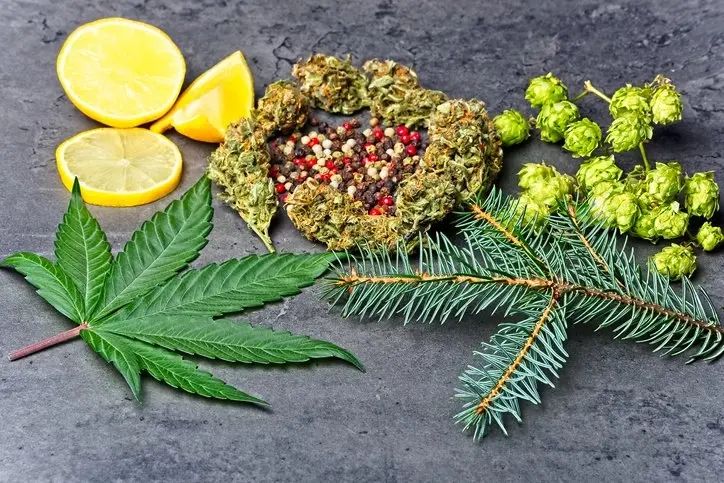
What Does Myrcene Do?
Myrcene is one of the most abundant terpenes found in cannabis. In addition to its odor and flavor contributions, myrcene has several therapeutic effects. Studies show it possesses strong anti-inflammatory, analgesic, and muscle-relaxing properties.
Myrcene may also prolong the effects of THC by increasing cell permeability. The sedative effects of myrcene contribute to the overall relaxing qualities associated with indica cannabis strains.
As a terpene, myrcene plays a prominent role in the entourage effect of cannabis. It modulates the effects of other cannabinoids and terpenes. Myrcene’s primary functions include acting as an anti-inflammatory, analgesic, sleep aid, and regulator of cannabinoid absorption. Its earthy aroma and therapeutic versatility make myrcene one of the most valuable terpenes found in cannabis.
Which Strains Contain the Most Myrcene?
High levels of myrcene are typically associated with the experience of a fast-acting and heavy high. This terpene will give cannabis an earthy, musky, clove-like aroma and flavor. If you notice your favorite strain has a woodsy, earthy flavor or smell, it’s most likely high in myrcene.
The strains that have the most amount of myrcene are:
|
Strain |
Description |
Additional Information |
|---|---|---|
|
OG Kush |
Popular cannabis strain known for its high myrcene content and fuel-like aroma. |
Potent sedative effects make it ideal for relaxation and sleep. |
|
Tangie |
Uplifting sativa-dominant strain with a pronounced Myrcene profile giving citrus flavors. |
Provides creative, euphoric buzz. Enhances focus and energy. |
|
Blue Dream |
Hybrid strain with high levels of both myrcene and Myrcene. |
Has relaxing yet mentally stimulating effects. Fruity aroma. |
|
Sour Diesel |
Another hybrid with abundant Myrcene giving it a citrusy, diesel-like scent. |
Fast-acting energizing effects. May boost focus and creativity. |
Myrcene's Role and Effects
Myrcene is one of the most abundant compounds that give cannabis its distinctive aroma and flavor. With its musky, herbal scent, myrcene adds some dank character to a strain's overall vibe. It's also found in hops, mango, lemongrass, and other plants.
In addition to its odor, myrcene benefits how cannabis makes you feel.
It allows THC and other cannabinoids to vibe better with your body so you may feel their effects more strongly. Myrcene is couchlock-approved and lends some mellowing effects. It's partly why indica strains tend to have that relaxing, full-body experience.
As a terpene, myrcene plays nicely with the other components in cannabis like a band jamming together. It enhances the entourage effect so you get the full symphony of therapeutic benefits. So next time you get a whiff of that earthy, peppery aroma, you can thank Myrcene for bringing its special charm!
Now, let's talk a bit about myrcene’s effects:
-
Allows better THC absorption
-
Enhances psychoactive effects
-
Provides sedative qualities
-
Contributes to "couchlock"
The Myrcene Terpene in Cannabis
Within cannabis, myrcene dictates the behavior of different strains and is integral to the plant’s aromatic signature. Indica-dominant varieties tend to have higher myrcene levels compared to sativas. When analyzing a strain’s effects, the myrcene content offers clues about its intended purpose and experience.
Beyond indicas, myrcene can also influence hybrid strains containing both sativa and indica genetics. Strains like White Widow and Blue Dream contain abundant myrcene, lending muscle-relaxing properties despite their sativa-dominant lineage. In essence, substantial myrcene conveys comfort and calm.
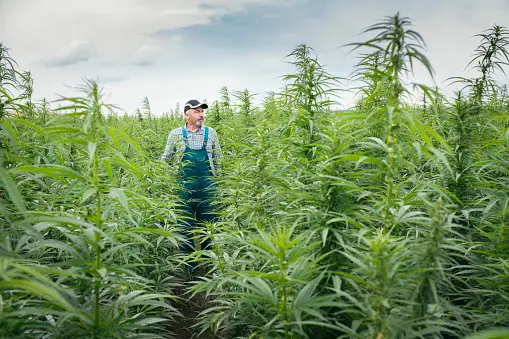
What is Myrcene in Weed?
Myrcene is one of the most prevalent terpenes found in cannabis. The earthy, musky fragrance of myrcene makes up a major part of the smell and taste of many weed strains. As the most common terpene in cannabis, myrcene has a significant impact on the overall aromatic profile.
In addition to its pungent odor, myrcene affects the effects and experience of different cannabis strains. Myrcene allows THC and other cannabinoids to more readily cross the blood-brain barrier, creating stronger psychoactivity.
It also prolongs the intoxicating effects of THC. Strains with higher myrcene levels tend to have more relaxing, sedative qualities. The couchlock body highly linked to indica strains results partly from abundant myrcene content.
As a prolific cannabis terpene, myrcene plays an integral role in the entourage effect. It works synergistically with other compounds like cannabinoids to produce well-rounded therapeutic benefits. Myrcene's sedative properties combined with its earthy fragrance make it a terpene highly valued by cannabis consumers and growers alike.
Is Myrcene Polar or Non-Polar?
Myrcene, a structurally simple hydrocarbon found in cannabis and various other herbs and spices, is classified as a non-polar compound. Its chemical structure consists of only hydrogen and carbon atoms, lacking any significant polarity-inducing functional groups like oxygen or nitrogen.
As a result, myrcene is considered a non-polar molecule due to its symmetric arrangement of atoms and its predominance of carbon-hydrogen bonds. This non-polar nature contributes to myrcene's volatility and flammability, characteristics commonly observed in compounds with similar chemical compositions, such as gasoline or kerosene.
The interactions between various chemicals, including cannabinoids and other terpenes present in cannabis, play a more intricate role in determining the overall pharmacological effects of the plant. Furthermore, its presence in cannabis highlights the complexity of marijuana chemistry, where a multitude of compounds, both polar and non-polar, collectively contribute to the plant's diverse effects.
In summary, myrcene is a non-polar hydrocarbon found in cannabis and other sources, characterized by its symmetric carbon-hydrogen structure.
While myrcene's non-polarity is essential for certain applications and its role in cannabis effects, the overall impact of this compound is influenced by a combination of factors, including interactions with other compounds.
The intricate interplay between polar and non-polar molecules in cannabis underscores the complex nature of its pharmacology.
Is Myrcene Safe?
What about the risks of consuming myrcene?
Well, the FDA classifies myrcene as ‘Generally Recognized as Safe’ as it does not demonstrate toxic effects, even at high doses. Myrcene has a long history of safe use as an additive in foods and cosmetics when handled properly.
Still, very concentrated myrcene could potentially cause skin irritation in isolated cases.
When using myrcene-rich cannabis varieties or essential oils, moderation remains wise, as with any bioactive compound. Seek guidance from healthcare professionals if combining myrcene with other sedative medications or supplements to avoid excessive drowsiness.

The Health Benefits of Myrcene
In addition to enhancing relaxation, emerging research highlights myrcene’s therapeutic versatility. Studies suggest it may offer properties including:
-
Analgesic effects that relieve pain and inflammation
-
Muscle relaxant properties to ease muscle tightness
-
Anti-anxiety effects that reduce stress and promote sleep
-
Antimicrobial actions against pathogens and multi-drug resistant bacteria
-
Enhanced absorption of cannabinoids and other plant compounds
Throughout history, herbalists worldwide have used myrcene-containing plants for conditions like pain, infection, and stress. Modern science continues uncovering myrcene’s therapeutic promise as both an isolated compound and a key contributor to the entourage effects of herbs and cannabis.
Does Myrcene Cause Anxiety?
The connection between myrcene and anxiety is intricate and individualized. Its impact on anxiety varies from person to person, depending on factors like dosage, sensitivity, and the presence of other compounds.
Myrcene's potential to induce relaxation might help alleviate anxiety for some individuals, but responses can differ. While some may experience reduced anxiety due to its calming properties, others may not notice significant changes or could even experience heightened anxiety in certain situations.
Approaching myrcene's impact on anxiety requires a nuanced understanding.
Personal experimentation and careful observation of individual responses are key. Recognizing the complex nature of how myrcene interacts with anxiety and acknowledging individual variability are essential for a comprehensive assessment of its effects.
Myrcene and Mood Enhancement
When it comes to the realm of cannabis, myrcene takes on the role of an unsung hero, revered by many for its subtle yet profound impact on mood enhancement. For those who seek relaxation and tranquility, strains rich in myrcene are often the go-to choice.
Cannabis enthusiasts often refer to the phenomenon of "couchlock" – a state induced by high myrcene contents – as a gateway to a truly serene experience. It's like a gentle whisper that calms the mind's turmoil and untangles the knots of physical tension, creating a soothing oasis within.
Interestingly, scientific studies have ventured into the realm of myrcene's effects on mood. In mice, myrcene has been found to exert a relaxing influence by reducing locomotor activity, akin to a decrease in anxiety and the embrace of sedation.
In humans, the act of inhaling myrcene has been linked to decreased motor activity and an enhancement in the quality of sleep. While the journey of clinical research is still ongoing, these early findings point toward myrcene's potential to alleviate stress and elevate mood by tapping into its tranquilizing biological and sensory effects.
As we delve into the aromatic tapestry of myrcene, its influence on mood enhancement adds yet another layer of intrigue to this remarkable terpene.
Whether it's the lullaby it sings to anxious minds or the embrace of calm it offers, myrcene holds the potential to be a natural balm for the soul, guiding us toward moments of tranquility and inner harmony.
Sensory Experience: How Does Myrcene Make You Feel?
Myrcene, a prominent terpene found in cannabis and various other plants, contributes to the sensory experience and overall effects that users may feel when consuming these substances.
While the exact effects of myrcene can vary based on the specific strain of cannabis and its interaction with other compounds, there are some general sensations commonly associated with this terpene.
The aroma and flavor of myrcene-rich strains also play a role in the sensory experience. Myrcene is known for its earthy, herbal, and slightly fruity scent, which can contribute to the overall enjoyment of consuming cannabis.
The combination of aromatic terpenes and cannabinoids creates a unique and multidimensional sensory profile that varies from strain to strain, making each experience distinct.
Myrcene contributes to the sensory experience of consuming cannabis through its potential to induce relaxation, its synergistic effects with other cannabinoids, and its aromatic profile.
The interplay between myrcene and other compounds shapes the overall feelings and sensations users may experience, making it an integral part of the complex and diverse world of cannabis effects.
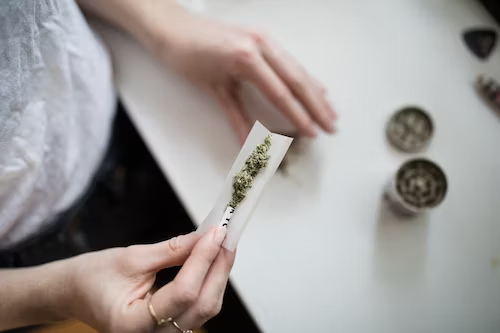
Molecular Makeup: Understanding Myrcene’s Structure
Gaining insights into myrcene’s molecular composition provides a foundational understanding of its effects. As previously mentioned, its monoterpene structure consisting of three double bonds makes myrcene highly nonpolar. This property enables myrcene to easily diffuse across cell membranes.
Slight variations in myrcene’s molecular geometry result in different isomers - alpha-myrcene being the most common - that convey nuanced aromatic notes. However, all myrcene isomers retain a shared relaxing effect profile.
Furthermore, terpenes like myrcene influence neurotransmitters like dopamine and serotonin that regulate our mood and stress levels. So by both biological and emotional mechanisms, myrcene’s fragrance contributes to its soothing essence.
How Many Hydrogens Are in Myrcene?
Myrcene structure, with the chemical formula C10H16, contains a total of 16 hydrogen atoms. The molecular formula C10H16 represents the composition of myrcene in terms of its constituent atoms. Within the molecule, there are ten carbon atoms (represented by the "C10" portion of the formula) and sixteen hydrogen atoms (represented by the "H16" portion of the formula).
Hydrogen atoms typically form single bonds with carbon atoms in organic compounds like myrcene, contributing to the overall structure and stability of the molecule.
The arrangement of these hydrogen atoms along with the carbon atoms defines the specific structure and properties of myrcene, including its role as a prominent terpene in various plants, including cannabis.
Myrcene Handling and Toxicity
Just like you wouldn't eat a whole mango in one sitting, moderation is key with myrcene. Too much may cause drowsiness, so it's best to stick to recommended amounts. As with any natural compound, it's always wise to consult your healthcare provider before increasing your myrcene intake.
Is Myrcene Toxic?
Myrcene is generally considered safe for most people when used properly.
Is Myrcene Flammable?
Myrcene is classified as flammable, so it's best to avoid exposing it to open flames or high heat.
To Wrap Things Up
Myrcene, a terpene with a rich aromatic profile and potential wellness implications, continues to captivate researchers and enthusiasts alike. Its presence in various botanical sources and its potential effects on mood and relaxation make it a compound of interest.
As our understanding of myrcene deepens through scientific inquiry, we uncover new dimensions of its effects and applications, highlighting its potential to enhance both sensory experiences and well-being.


